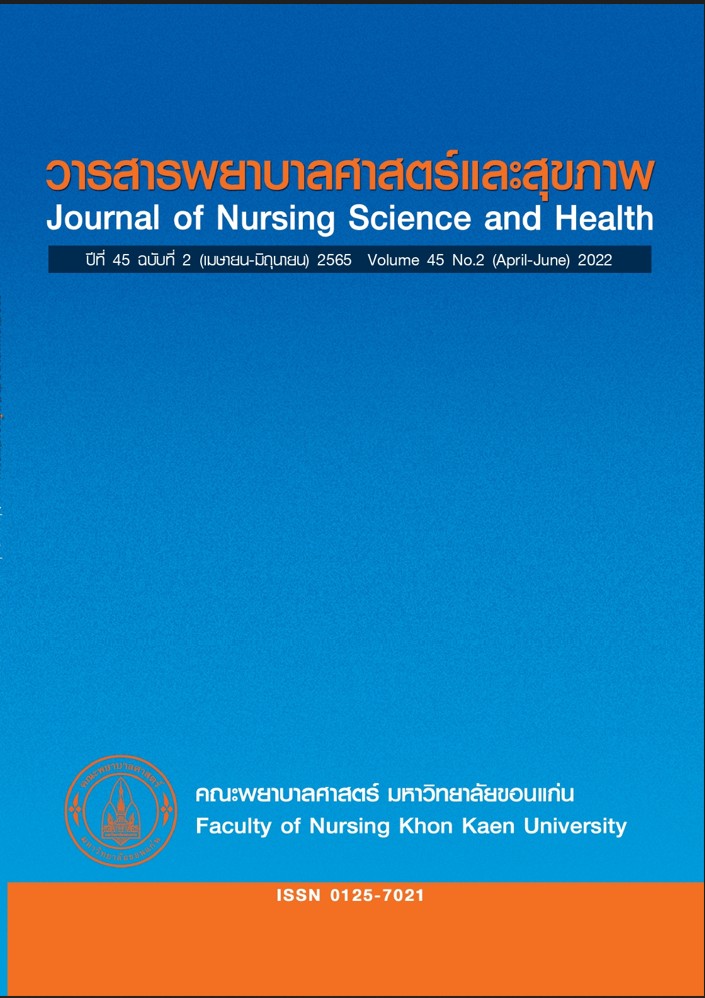กลยุทธ์ในการสร้างครูพยาบาลมืออาชีพจากพยาบาลจบใหม่ โดยรองศาสตราจารย์สายหยุด นิยมวิภาต: การวิเคราะห์ข้อมูลทุติยภูมิเชิงประวัติศาสตร์จากข้อมูลเชิงคุณภาพ
คำสำคัญ:
กลยุทธ์การสร้างครูพยาบาลจบใหม่, การวิเคราะห์ข้อมูลทุติยภูมิเชิงคุณภาพ, รองศาสตราจารย์สายหยุด นิยมวิภาตบทคัดย่อ
ความสำเร็จในการสร้างพยาบาลจบใหม่จากการปฏิบัติทางคลินิกไปสู่การเป็นครูผู้สั่งสอนวิชาการเป็นสิ่งสำคัญในการสร้างบุคลากรพยาบาลสู่สังคม โดยเฉพาะอย่างยิ่งในการเตรียมครูพยาบาลในสังกัดคณะพยาบาลศาสตร์ที่จัดตั้งเป็นครั้งแรกในประเทศไทย ซึ่งนำโดยรองศาสตราจารย์สายหยุด นิยมวิภาต ท่ามกลางปัจจัย เอื้ออำนวยที่ขาดแคลนไปทุกสิ่ง กลยุทธ์ที่ใช้จึงเป็นสิ่งที่น่าเรียนรู้เป็นอย่างยิ่ง วัตถุประสงค์การวิจัยเพื่อศึกษากลยุทธ์ในการสร้างครูพยาบาลจากพยาบาลจบใหม่โดยรองศาสตราจารย์สายหยุด นิยมวิภาต วิธีการวิจัยเป็นการวิเคราะห์ข้อมูลทุติยภูมิเชิงคุณภาพ จากเอกสารประวัติศาสตร์การก่อตั้งคณะพยาบาลศาสตร์ถึงกลยุทธ์ในการสร้างพยาบาลจบใหม่สู่การเป็นครูพยาบาลรุ่นแรกของคณะพยาบาลศาสตร์ มหาวิทยาลัยขอนแก่น จำนวน 7 ฉบับ การสัมภาษณ์เชิงลึกในกลุ่มผู้ให้ข้อมูลซึ่งเป็นอาจารย์และนักศึกษารุ่นแรก บันทึกเสียงและถอดคำสัมภาษณ์แบบ
คำต่อคำ แล้ววิเคราะห์เนื้อหา ผลการศึกษาเกี่ยวกับกลยุทธ์ที่รองศาสตราจารย์สายหยุด นิยมวิภาต ประยุกต์ใช้ในการสร้างครูพยาบาลมืออาชีพจากพยาบาลจบใหม่ ประกอบด้วย 1) การสร้างความรู้สึกเป็นเจ้าขององค์กร และมีส่วนรวมในทุกการดำเนินการ 2) การสร้างอัตลักษณ์-คุณค่า-อุดมการณ์วิชาชีพการพยาบาล และ 3) จัดให้
มีประสบการณ์: ผ่านการจัดกิจกรรมและทำบทบาทตัวอย่างสนับสนุน
สรุปได้ว่ากลยุทธ์ที่รองศาสตราจารย์สายหยุด นิยมวิภาต นำมาใช้เพื่อเอื้ออำนวยให้เกิดการเปลี่ยนแปลงนี้ ส่วนใหญ่เป็นการกระทำบทบาทในลักษณะไม่เป็นทางการเพื่อสร้างแรงบันดาลใจให้ครูมือใหม่เป็นครูพยาบาลมืออาชีพและมีความผูกพันต่อองค์กรและอยู่ในองค์กรจนกระทั่งเกษียณอายุงาน จึงอาจเป็นประโยชน์แก่ผู้สนใจนำกลยุทธ์นี้ไปประยุกต์ใช้ต่อไป
เอกสารอ้างอิง
Niyomviphat S. Reminiscing to the past and congratulations. In a book on the twenty-year anniversary of the faculty of nursing, Khon Kaen university. Khon Kaen: Siriphaan Offset;199:p.8-9. (in Thai)
Jongudomkarn D, Lertrt P. The emergence of the first nursing faculty of nursing in Thailand: A step towards professional autonomy. JNSH 2014;37(2):57-70 (in Thai)
Jahandar P, Tafreshi MZ, Rassouli M, Atashzadeh-Shoorideh F, Kavousi A. Nurses’ perspective on spiritual leadership: A qualitative study based on fry’s spiritual leadership model. Electronic Physician 2017;9(11):5721-31. Available from: http://dx.doi.org/10.19082/5721
Booth TL, Emerson CJ, Hackney MG, Souter S. Preparation of academic nurse educators. Nurse Educ Pract 2016;19:54-7. doi:10.1016/j.nepr.2016.04.006. Epub 2016 May 6. PMID:27428693.
Anderson J. The work–role transition of expert clinician to novice academic educator. J Nurs Educ 2009;48(4):203-8. Available from: https://doi.org/10.3928/01484834-20090401-02
Rujkorakarn D. Presentation document nursing conference;2014. [cited 2022 Feb 25]. Avaliable form: http://www.nur.psu.ac.th/nur/news_show.aspx?id=13191. (in Thai)
Laari TT, Apiribu F, Gazari T, Akor MH, Mensah ABB, Atanuriba GA, et al. Strategies adopted by novice nurse educators to facilitate their transition from practice to academia: A qualitative study in Ghana. SAGE Open Nursing 2021;7:1–10. DOI:10.1177/23779608211035209
Kelly K. Is the DNP the answer to the nursing faculty shortage? Not likely! Nurs Forum 2010 Oct-Dec;45(4):266-70. doi: 10.1111/j.1744-6198.2010.00197.x.PMID: 21077896.
Niyomviphat S. Significance statement of establishing the he first nursing faculty of nursing in Thailand. Newsletter of Brick Color, Khon Kaen: Copy printed;1971. (in Thai)
Thongsong W. Nursing leadership development of Associate Professor Saiyud Niyomviphatt. Master degree thesis report of nursing administration, Graduate School, Chiang Mai University;1996. (in Thai)
Edutorial team. A book on the twenty-year anniversary of the faculty of nursing, Khon Kaen university. Khon Kaen: Siriphaan Offset;1991.p.10-6. (in Thai)
Sandeloski M. Whatever happened to qualitative description? Res Nurs Health 2000;23(4):334-40. doi:10.1002/1098240x(200008)23:4<334:aid-nur9>3.0.co;2-g. PMID: 10940958.
Long-Sutehall T, Sque M, Addington-Hall J. Secondary analysis of qualitative data: A valuable method for exploring sensitive issues with an elusive population?. JRN 2010;16(4):335-4 4. DOI:10.1177/1744987110381553
Morgan DL. Focus groups. In Hesse-Biber SN, Leavy P, editors. Approach to qualitative research: A reader on theory and practice. New York: Oxford University Press;2004:p.263-85
Bryman A. Social research methods. Oxford: Oxford University Press; 2001.
Paley J. Positivism and qualitative nursing research. Sch Inq Nurs Pract 2001 Winter;15(4):371-87; discussion 389-97. PMID:11885869.
Attride-Stirling J. Thematic networks: An analytic tool for qualitative research. Qual Health Res 2001;1(3):385-405.
Holloway I, Wheeler S. Qualitative research in nursing, 2nd ed. Oxford, UK.: Blackwell;2002.
Sanjari M, Bahramnezhad F, Fomani FK, Shoghi M, Cheraghi MA. Ethical challenges of researchers in qualitative studies: The necessity to develop a specific guideline. J Med Ethics Hist Med 2014; 7:14.
Jongudomkarn D. Two decades of commitment to forming the Faculty of Nursing, Khon Kaen University. In a book on the twenty year anniversary of the faculty of nursing, Khon Kaen university. Khon Kaen: Siriphan Offset;1991:p.17-22. (in Thai)
Raman S. Sense of belonging. In: Michalos AC, editors. Encyclopedia of quality of life and well-being research 2014, Springer, Dordrecht. Available from: https://doi.org/10.1007/978-94-007-0753-5_2646
Woods A, Cashin A, Horstmanshof L. The social construction of nurse educator professional identities: Exploring the impact of a community of practice through participatory action research. J Adv Nurs 2022 Apr 5. doi: 10.1111/jan.15200. Online ahead of print.
Andrew N, Ferguson D, Wilkie G, Corcoran T, Simpson L. Developing professional identity in nursing academics: The role of communities ofpractice. Nurse Educ Today 2009; 29(6): 607-11. doi: 10.1016/j.nedt.2009.01.012. Epub 2009 Feb 27. PMID: 19250718.
Jafari H, Mohammadi E, Ahmadi F, Kazemnejad A, Shorofi SA. The experience of nursing instructors and students on professional
competency of nursing academic staff: A qualitative study. Glob J Health Sci 2014 Apr 14;6(4):128-35. doi: 10.5539/gjhs. v6n4p128. PMID: 24999130; PMCID: PMC4825461.
Held D. Cosmopolitanism: Ideals and Realities. Cambridge: Polity Press;2010.
Cameron JD. Grounding experiential learning in ‘Thick’ conceptions of global citizenship. In: Tiessen R, Huish R, editors, Globetrotting or global citizenship? perils and potentials of experiential Learning, Toronto: University of Toronto Press;2013:p.21-42.
Rai A, Maheshwari S. Exploring the mediating role of work engagement between the linkages of job characteristics with organizational engagement and job satisfaction. MRR 2021; 44(1): 133-57. Available from: https://doi.org/10.1108/MRR-10-2019-0442
Tourish D, Jackson B. Guest editorial: Communication and leadership: An open invitation to engage. Leadership 2008;4(3):219-25. doi:10.1177/1742715008092359
Sanongyart J, Buasuwan P, Hemtanon S. Factors to create a professional learning community of nursing instructors. JMND [Internet]. 2019 Nov 24 [cited 2022 May 10];6(9):4250-6. Available from: https://so03.tci-thaijo.org/index.php/JMND/article/view/223448
ดาวน์โหลด
เผยแพร่แล้ว
รูปแบบการอ้างอิง
ฉบับ
ประเภทบทความ
สัญญาอนุญาต
ลิขสิทธิ์ (c) 2022 วารสารพยาบาลศาสตร์และสุขภาพ

อนุญาตภายใต้เงื่อนไข Creative Commons Attribution-NonCommercial-NoDerivatives 4.0 International License.
วารสารพยาบาลศาสตร์และสุขภาพเป็นเจ้าของลิขสิทธิ์ในการเผยแพร่ผลงานที่ตีพิมพ์ห้ามผู้ใดนำบทความที่ได้รับการตีพิมพ์ในวารสารพยาบาลศาสตร์และสุขภาพไปเผยแพร่ในลักษณะต่าง ๆ ดังนี้ การนำบทความไปเผยแพร่ออนไลน์ การถ่ายเอกสารบทความเพื่อกิจกรรมที่ไม่ใช่การเรียนการสอน การส่งบทความไปตีพิมพ์เผยแพร่ที่อื่น ยกเว้นเสียแต่ได้รับอนุญาตจากวารสารพยาบาลศาสตร์และสุขภาพ



